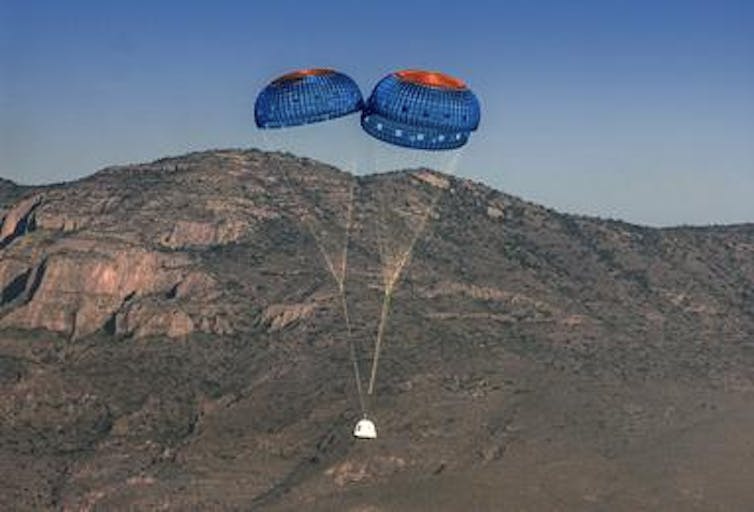Billionaire entrepreneur Richard Branson and his team successfully flew to the “edge of space” on the Unity 22 mission aboard a Virgin Galactic plane on July 12. The event was hailed as the start of space tourism, narrowly beating the planned launch on 20 July by fellow billionaire business magnate Jeff Bezos and his firm Blue Origin.
But does the 85km (53 miles), the altitude of the recent Virgin Galactic flight, actually count as space? And what are these companies likely to achieve going forward?
The definition of where space begins is very subjective. The Kármán line is a distance of 100km (62 miles), determined in 1957. This line has been adopted by the Swiss Air Sports Federation (Fédération Aéronautique Internationale) to determine if an activity is aeronautical or astronautical.
Alternatively, the US Air Force and Nasa determine their boundary as 80km (50 miles), which is where military personnel get their “astronaut wings”. This altitude has been reached by a number of specialist planes including the X-15 and notably the privately funded SpaceShipOne, reaching 112km (70 miles) – well above VSS Unity’s current achievement. The Blue Origin launch is aiming for 106km (66 miles).
Get your news from people who know what they’re talking about.
Hear from them
While this altitude allows some excellent views of the Earth, it is not an orbit. To be orbiting at this altitude you need to be travelling at a minimum speed of 7.85km/s (17,500mph) in a horizontal direction. Unity was just an acceleration straight up and then a controlled drop back down. This is relatively simple to do, but it’s significantly more difficult, both in terms of energy and engineering, to turn this into an orbit.
The definition of the edge of space is not trivial. Space is not where you feel weightless, as this can be achieved for short periods of time in specialist drop chambers or on parabolic flights. And despite the tweet from Virgin Galactic stating the crew were in zero-gravity, the gravitational pull was roughly 9.5 metres per square second – about 97% of that on the surface. The weightlessness experienced is purely due to an extended free fall.https://platform.twitter.com/embed/Tweet.html?dnt=false&embedId=twitter-widget-0&features=eyJ0ZndfZXhwZXJpbWVudHNfY29va2llX2V4cGlyYXRpb24iOnsiYnVja2V0IjoxMjA5NjAwLCJ2ZXJzaW9uIjpudWxsfSwidGZ3X2hvcml6b25fdHdlZXRfZW1iZWRfOTU1NSI6eyJidWNrZXQiOiJodGUiLCJ2ZXJzaW9uIjpudWxsfX0%3D&frame=false&hideCard=false&hideThread=false&id=1414290124779626499&lang=en&origin=https%3A%2F%2Ftheconversation.com%2Fvirgin-galactic-and-blue-origin-can-they-be-more-than-space-joyrides-for-millionaires-164513&sessionId=50b11dbecb1cf3cec12d07ceb2d7b1dee859e7ef&siteScreenName=ConversationUK&theme=light&widgetsVersion=82e1070%3A1619632193066&width=550px
Future outlook
The first billionaire in space has excited some, feeling that they too may one day see the Earth from 85km if they can afford US$250,000 for a one-hour trip. However, public opinion has not been unanimous, with many highlighting that the cost of the venture could be used to eradicate poverty or assist with the current pandemic response.
There’s also the environmental impact. According to Virgin Galactic, a single flight on Unity results in carbon emission of 1.2 tonnes – equivalent to a passenger in business class on a return trip from London to New York. Compared to aviation, this is small, but the more regular these flights become the more carbon will be added. Blue Origin’s engines, on the other hand, are powered by liquid hydrogen. While the emissions are therefore minimal, the generation of liquid hydrogen and carbon cost of transporting materials is still an issue.

Although Virgin Galactic has beaten Blue Origin to the punch – SpaceX is ahead of both in terms of private space exploration. It is focusing on launches to the International Space Station and much more adventurous space tourism, such as a trip to the Moon and back, which definitely classes as going into space. The success rate of SpaceX, including the Crew Dragon 2 craft, means that its dearMoon project has a good chance of succeeding, although not for a few years yet. The plan is to develop a new rocket, known as Starship, to launch this first space tourism venture.
Meanwhile, Virgin Galactic is developing a concept supersonic passenger transporter as a successor to the Concorde that would be able to fly up to 19 people from Los Angeles to Sydney in under seven hours. It also won a small contract with Nasa to do research on its flights.
Blue Origin has also collaborated with Nasa to develop concept and technologies to support future human spaceflight operations. The current development is a concept robotic lunar lander dubbed Blue Moon, which is looking to deliver cargo – and maybe even crew – to the Moon. These projects will certainly provide more experience for the companies, although are a long way off being completed or tested.
Virgin Galactic’s sister company Virgin Orbit, a low-cost, small satellite launch plan, is far more impressive. It has already completed two successful missions, deploying payloads to low Earth orbit. This works in a similar way to Virgin Galactic by having the LauncherOne rockets attached to a carrier plane (Cosmic Girl) and firing at an altitude of 10km. This is a good alternative for launching small, lightweight satellites to about 500km, so that they don’t have to wait for an opening on larger rockets.
Branson has completed his lifelong dream, and Bezos and passengers are on the brink of going a bit higher, but to the vast majority of people who will never get to experience such a flight it is of little importance. No new records have been broken and no new technology has been tested. The real excitement will come when these companies are able to reach orbit, willing to trial new technologies, assist significantly with scientific research, and open their doors to more people who aren’t super rich.
About the Author
This article was written by
- Ian Whittaker, senior lecturer in physics, Nottingham Trent University.
- Gareth Dorrian, post doctoral research fellow in Space Science, University of Birmingham.





























